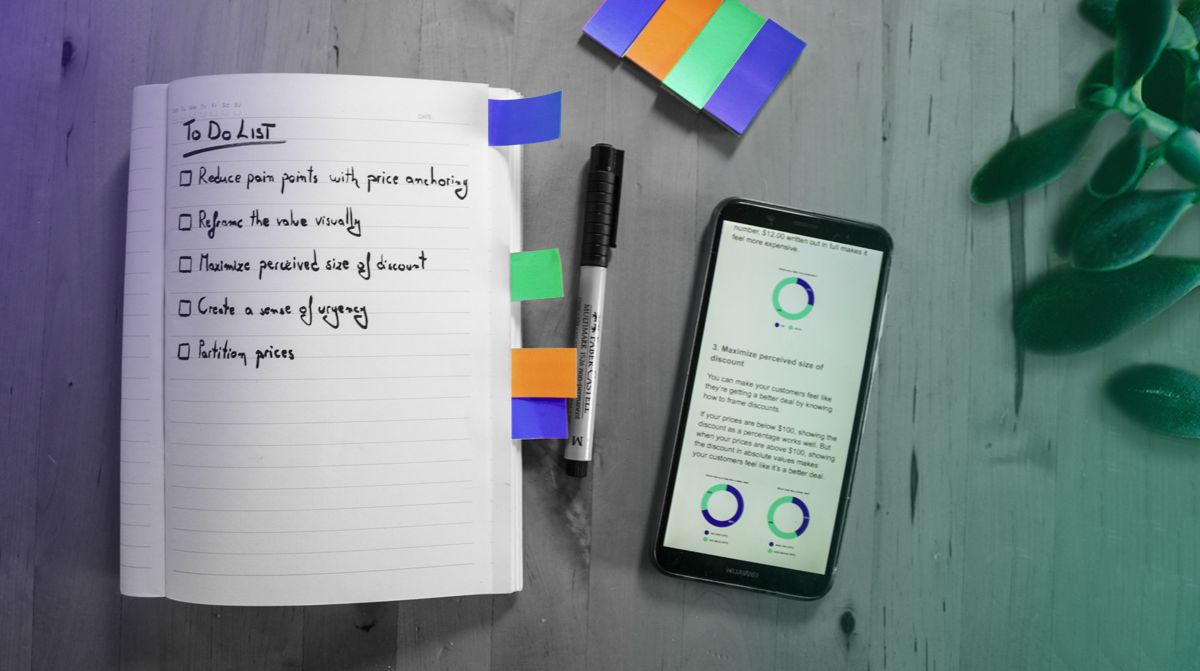There’s a lot that goes into SaaS pricing.
Decide on a pricing model. Will it be subscription-based pricing? Maybe consumption-based pricing?
Choose a currency. Do you price in USD or in the local currency?
Understand your customer’s willingness to pay and determine your number. Factor in customer behavior and adapt prices optimally across segments.
But sometimes, the difference between a yes or no is as simple as a number. Or a visual display. Because pricing is more than just what the price should be. How you price products is also crucial.
So if you’ve ever wondered whether price displays affect a consumer’s decision... Yes, they do. We’ll show results from our pricing psychology survey which prove it.
This means that there’s another strategy your SaaS company can employ: Pricing psychology.
The impact of pricing psychology on your bottom line
Pricing psychology isn’t magic or pseudo-science. It is a marketing and business strategy based on the theory that certain prices have a psychological impact on consumers. That psychological impact either encourages or discourages the consumer from buying.
Dan Ariely, a behavioral economist and author of Predictably Irrational, did research to show how seemingly useless pricing points impact consumer behavior. For his study of subscription prices for The Economist magazine, he set the following three prices:
- $59 for web only
- $125 for print only
- $125 for web and print bundle
What’s the point of the $125 print-only price? It’s a useful decoy. Results showed that with the print-only price decoy, web and print bundled purchases made up 84% of the magazine’s purchases, while web-only subscriptions made up 16%. When the print-only price decoy was removed, web and print bundled purchases made up only 32% of the magazine’s purchases, while web-only subscriptions made up 68%.
The takeaway is that you can affect the perceived value of an item or service with the right pricing strategy.
Harnessing the power of the nudge and behavioral pricing globally
Here’s where behavioral pricing and the use of Nudge Theory come into play.1
Behavioral pricing, or pricing psychology, operates under the notion that by influencing people’s perception of your price, you can motivate them to buy your product or service. It's about utilizing research findings and market data to maximize conversions.
Nudges, on the other hand, are mechanisms or tactics wherein you shape the consumer’s environment, influence their price perception, and make decision-making simpler. These may be in the form of visual or textual displays.
Before studies on behavioral economics emerged in the 70s, common knowledge was that humans were rational beings, especially when it came to economic decision-making. But research, such as Dan Ariely’s study mentioned above, has proven that the consumer can be irrational—even predictably so.
For SaaS companies, behavioral pricing theories and nudges can serve as tools to remove purchase barriers, win customer trust, and boost conversions.
5 pricing psychology tactics that work for any market
We ran a pricing psychology study to understand how 1,000 consumers feel about certain prices, solely based on how they’re shown visually. The next time you price, it’s worth thinking about how your prices are displayed.
1. Reduce pain points with price anchoring
By showing the lump sum amount, consumers are anchored to the high price point. Showing the amount in smaller increments anchors consumers to a lower price. This makes it seem more affordable, even though they’re around the same cost.
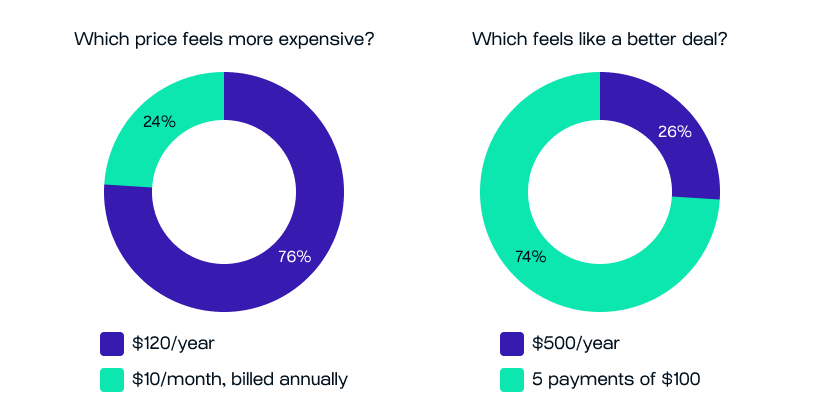
2. Reframe the value, visually
Remove the comma
When people see a price, they don’t only look at it with their eyes; they usually read it in their heads as well (and sometimes they also read it out loud). The first price then is read as “one thousand four hundred and ninety-nine, while the second is fourteen ninety-nine.
By simply removing the comma, you reduce the phonetic length of the price. This makes the price easier to sound out and makes the product seem more affordable.
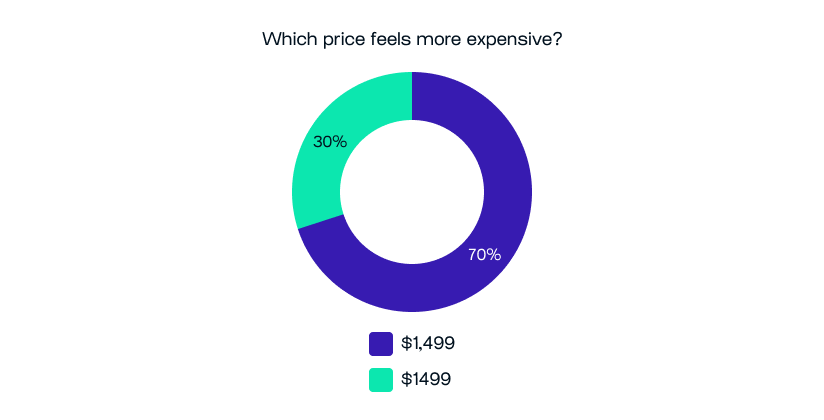
Use whole numbers to signal quality
A whole number price is commonly equated to quality and implies that an item isn’t discounted. While $12 is also a whole number, $12.00 written out in full makes it feel more expensive.
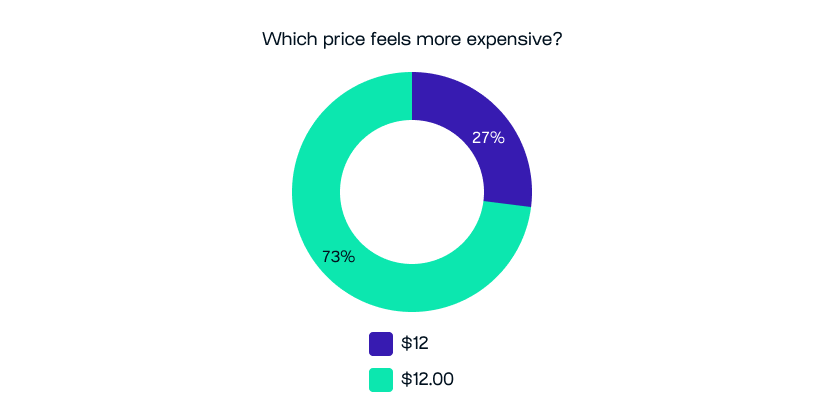
3. Maximize perceived size of discount
You can make your customers feel like they’re getting a better deal by knowing how to frame discounts.
If your prices are below $100, showing the discount as a percentage works well. But when your prices are above $100, showing the discount in absolute values makes your customers feel like it’s a better deal.
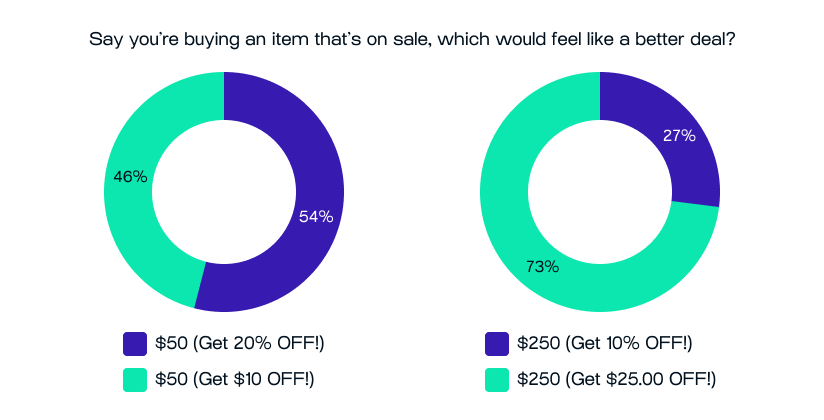
If you’re striking out the old price and showing the new, discounted price, place the sale price on the right side. This allows customers to easily calculate, going from a larger number to a smaller number, and lets them feel that they’re receiving a larger discount.

4. Create a sense of urgency
Limited time offers nudge customers to upgrade as they don't want to miss out on a good deal. This plays on the human tendency to prefer avoiding losses while at the same time wanting to gain more.

5. Partition prices
Partitioned pricing is separating a price into its parts (i.e. separating the base price from the shipping and handling price). When customers see partitioned prices, they are anchored into the base price and don’t focus on computing the total cost.
However, customers also love anything free. Throw in anything free and it will be positively received. Seeing the word “Free” makes it seem like a better deal. In our study, despite $15 having a lower base price, having free shipping in the first option made it feel like a better option.
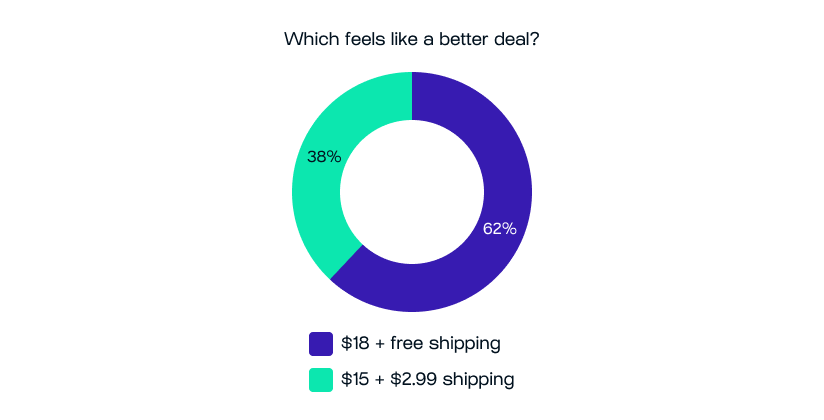
Make pricing psychology work for your SaaS business
To benefit from pricing psychology in any market, you must understand the field of study and how to put it into practice effectively. You also need a thorough understanding of different markets. While pricing psychology principles are similar, you will need to customize for consumer segments.
For example, in China, the numbers 6 and 8 are considered lucky, which is why many companies use those numbers in pricing. The number 4, which sounds like the word for death, is often avoided when pricing products. When operating in another country, take time to research and incorporate such cultural phenomena into your price localization strategy.
Leveraging pricing psychology isn't easy. Luckily, you don’t have to go through it alone.
Corrily is here to help you optimize pricing in every market. By leveraging our consumer psychology knowledge, market localization expertise, and a suite of pricing technologies, we can optimize pricing in any market for your SaaS business. Even better, we’ll run continual experiments to ensure your pricing stays dynamic and up-to-date with changes in consumer behavior.
To date, our clients have achieved an average revenue growth of 43.2% with our technology. If you’d like to see what we can do for you, let’s hop on a discovery call.
Footnotes
-
Richard Thaler came up with Nudge Theory, where he defines a nudge as “...any aspect of the choice architecture that alters people’s behavior in a predictable way without forbidding any options or significantly changing their economic incentives. To count as a mere nudge, the intervention must be easy and cheap to avoid.” ↩

